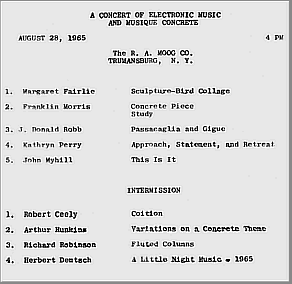|
Six months after the Greenwich Village concert, a small research grant from Hofstra University in Hempstead, Long Island enabled Moog and me to devote our time to concentrated daily experimentation on electronic musical instruments. I camped at Taughannok Falls, a State Park near Trumansburg, and we worked in his cellar. By the end of one week, Moog had designed the basic modules of an electronic music synthesizer. He worked on the basis of earlier experiments of other people and explored new areas. Music "synthesis" -- the combining of the elements of music (pitch, tone color, duration, loudness contour, and timbral contour) by a single instrument which enables the composer or performer to shape each element as he wishes -- had already been done electronically. The avant garde composer Edgard Varese, another New Yorker, although born and raised in France, incorporated the use of electronically synthesized sounds in his compositions during the early 1950's. And in 1937, Harald Bode, now a Tonawanda, New York resident, invented a synthesizer-like instrument in Germany. This instrument was the model for many of Moog's early thoughts about his synthesizer. Moog's particular contributions were in the employment of solid state devices controlled by the use of discreet D.C. voltage changes and in the design of filter architecture. His designs are responsible for both the reduced size of circuits and the distinctive sounds of today's synthesizers. The Moog filter design is as unique to the sounds of a synthesizer as the Steinway steel frame is to the sound of a piano.
The following year, 1965, the first prototype instruments were built. One of these prototypes, the property of the author, is presently on loan to Hofstra University. The other was the synthesizer we brought to Professor Ciamaga at Toronto University, where the instrument still is today.
Just after the trip to Canada, things began to move quickly.
 A dozen musicians gathered at a workshop in Trumansburg in the summer of 1965 to use the new instruments during a three-week period. By this time the R.A. Moog Company had been formed and Moog had a few assistants. These sessions provided valuable information about the sound and design of the instrument. Soon actual orders to buy the synthesizer began to appear. Alwin Nikolais, a New York City composer and choreographer placed the first order for a Moog synthesizer in 1965. Having composed his own scores using sounds rather than traditional dance music for the Nikolais Dance Theater, he immediately appreciated the possibilities of the Moog instrument.
A dozen musicians gathered at a workshop in Trumansburg in the summer of 1965 to use the new instruments during a three-week period. By this time the R.A. Moog Company had been formed and Moog had a few assistants. These sessions provided valuable information about the sound and design of the instrument. Soon actual orders to buy the synthesizer began to appear. Alwin Nikolais, a New York City composer and choreographer placed the first order for a Moog synthesizer in 1965. Having composed his own scores using sounds rather than traditional dance music for the Nikolais Dance Theater, he immediately appreciated the possibilities of the Moog instrument.
|